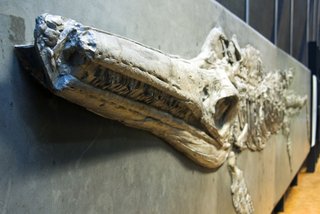Ichthyosaurs from Posidonia Shale
Ichthyosaurs (‘fish lizards’) were a group of tuna-shaped reptiles that inhabited Earth’s seas during the Mesozoic Era. Like today’s dolphins, ichthyosaurs had profound adaptions to aquatic environments including limbs transformed into flippers, a dorsal fin, and a tail fin.
Scientists have recognized the existence of these marine reptiles since the early nineteenth century, in part due to spectacularly preserved skeletons from the Early Jurassic of Germany (Posidonia Shale, Holzmaden). The Posidonia Shale has been quarried for over 200 years, yielding a huge number of marine vertebrate fossils, housed in museums all over the world. This locality has yielded thousands of spectacularly preserved ichthyosaur skeletons representing seven species, ranging in size from 2 to more than 10 meters in length and including fossilized soft tissues, stomach contents, and even embryos.
The discovery of a new species after so many years of research and collection effort was thought to be unlikely.







Comments (0)
No Comments